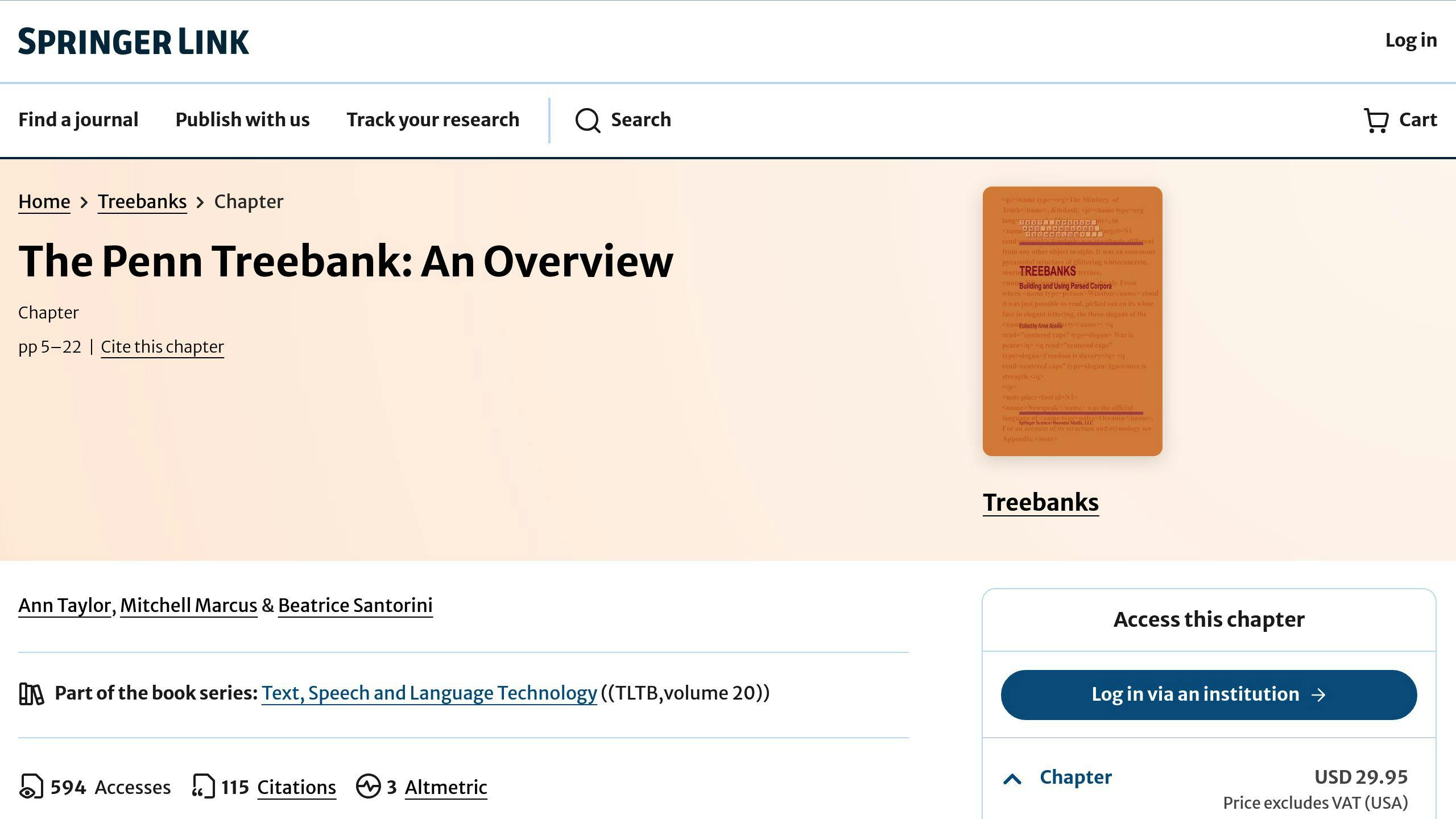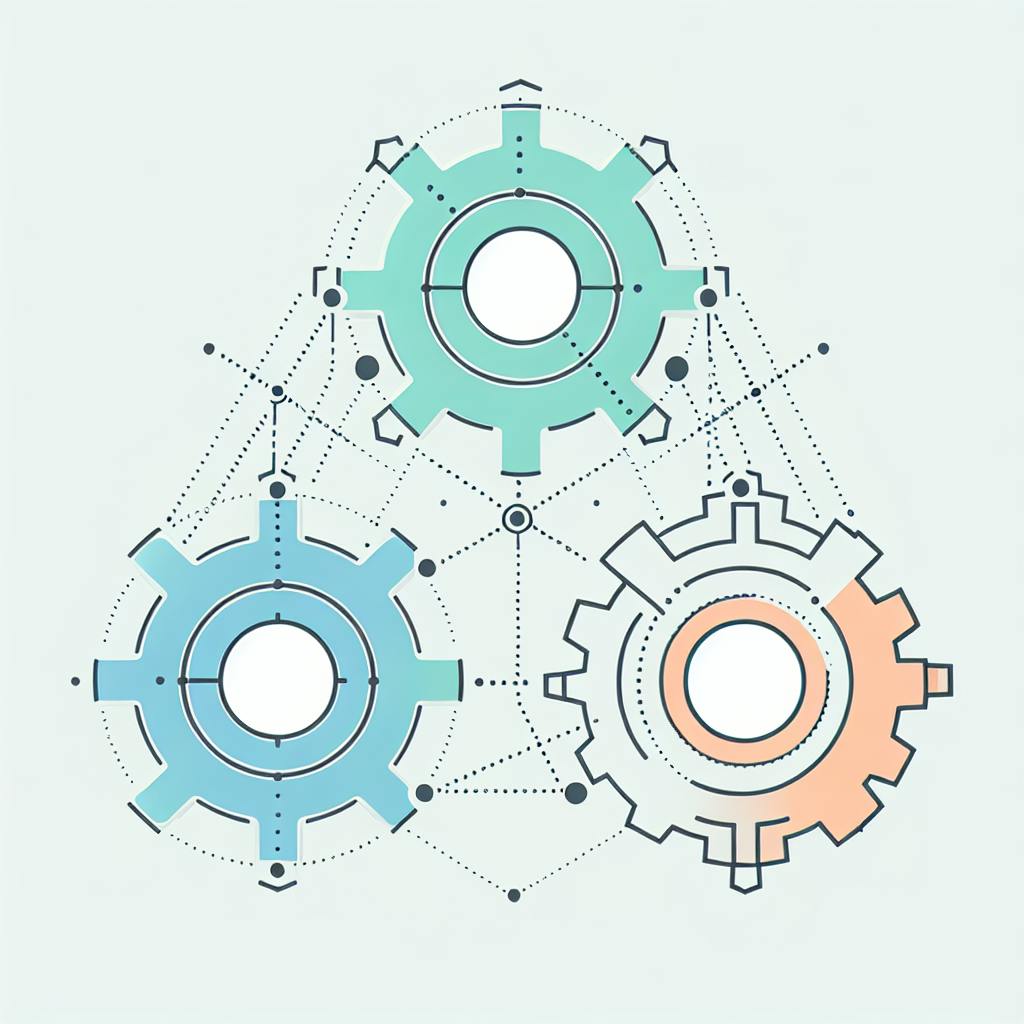Tokenization breaks text into smaller units for NLP tasks. Here's what you need to know:
- It's the first step in most NLP processes
- Helps machines understand human language
- Powers search engines, translation, and more
The 10 key tokenization methods:
- White Space: Splits on spaces (simple but limited)
- Word: Breaks into words (common for English)
- Sentence: Divides text into sentences
- Character: Splits into individual characters
- N-gram: Creates sequences of n items
- Regular Expression: Uses patterns to split text
- Penn Treebank: Handles contractions and punctuation
- Subword: Breaks words into smaller parts
- Byte Pair Encoding (BPE): Merges common character pairs
- WordPiece: Google's method for balancing words and subwords
Quick comparison:
| Method | Complexity | Best For | Drawback |
|---|---|---|---|
| White Space | Low | Simple tasks | Fails with some languages |
| Word | Low | General NLP | Struggles with contractions |
| Subword | High | Unknown words | More complex |
Choose based on your task, language, and data. There's no one-size-fits-all solution.
Related video from YouTube
What is Tokenization?
Tokenization breaks text into smaller units called tokens. It's the first step in many NLP tasks and helps machines understand human language.
Here's the deal with tokenization:
- It splits text into words, characters, or subwords
- It turns messy text into something computers can work with
- It's a MUST for text analysis and NLP applications
Check out this example:
Text: "I love ice cream!"
Tokens: ["I", "love", "ice", "cream", "!"]
The sentence is now individual words and punctuation.
Tokenization comes in three flavors:
1. Word-level: Splits into words (most common)
This is what you'll see most often. It's great for general text analysis.
2. Character-level: Breaks into individual characters
Useful for tasks like spell-checking or working with languages that don't use spaces.
3. Subword-level: Divides words into meaningful parts
This helps with handling new or uncommon words.
Tokenization is key in NLP apps:
| App | What Tokenization Does |
|---|---|
| Text Classification | Breaks text into analyzable chunks |
| Named Entity Recognition | Finds word boundaries |
| Sentiment Analysis | Separates words for emotion analysis |
| Machine Translation | Splits text for translation |
One last thing: tokenization isn't one-size-fits-all. English uses spaces between words, but Chinese doesn't. So, tokenization methods vary by language.
White Space Tokenization
White space tokenization is the simplest way to split text into tokens. It's a go-to method for many NLP tasks, especially with English text.
How does it work? The tokenizer splits the text at every space. Simple and fast.
Here's a quick example:
text = "India is my country"
tokens = text.split()
print(tokens)
# Output: ['India', 'is', 'my', 'country']
It's lightning-fast, but not perfect. It struggles with contractions, punctuation, and special cases like "New York".
So why use it? It's fast and simple. Great for:
| Task | Benefit |
|---|---|
| Quick text analysis | Fast processing |
| Simple word counting | Easy to implement |
| Basic text cleaning | Removes extra whitespace |
You can use it in Python two ways:
1. Built-in split() function:
tokens = "This is a sentence.".split()
2. NLTK's WhitespaceTokenizer:
from nltk.tokenize import WhitespaceTokenizer
tokenizer = WhitespaceTokenizer()
tokens = tokenizer.tokenize("This is a sentence.")
White space tokenization is a good start, but complex NLP tasks often need more sophisticated methods.
2. Word Tokenization
Word tokenization breaks text into individual words. It's a crucial step in NLP that helps machines process human language.
Here's the gist:
- Tokenizer splits text at spaces and punctuation
- Creates a list of separate "tokens"
Example:
text = "I love NLP!"
tokens = ["I", "love", "NLP", "!"]
It's great for sentiment analysis, classification, and translation. But it's not perfect. It can trip up on contractions, hyphens, and multi-word phrases.
Want to try it? Use NLTK in Python:
from nltk.tokenize import word_tokenize
text = "NLP is fascinating."
tokens = word_tokenize(text)
print(tokens)
# Output: ['NLP', 'is', 'fascinating', '.']
NLTK offers different tokenizers:
| Tokenizer | What it does |
|---|---|
| TreebankWordTokenizer | Uses Penn Treebank rules |
| WordPunctTokenizer | Splits on punctuation and spaces |
| WhitespaceTokenizer | Splits on whitespace only |
Pick the one that fits your needs and data best.
Word tokenization is just the beginning. More complex NLP tasks might need fancier tokenization methods.
3. Sentence Tokenization
Sentence tokenization breaks text into individual sentences. It's not just about periods - it handles complex punctuation and grammar rules.
Here's the gist:
- Find sentence boundaries
- Split the text
- Each sentence becomes a token
Let's see NLTK in action:
from nltk.tokenize import sent_tokenize
text = "God is Great! I won a lottery."
sentences = sent_tokenize(text)
print(sentences)
# Output: ['God is Great!', 'I won a lottery.']
Simple, right? But it's not always easy. Abbreviations, decimal points, and casual writing can trip up tokenizers.
That's why specialized tools exist. Take ClarityNLP for electronic health records. It:
- Cleans the text
- Replaces confusing elements
- Applies the tokenizer
- Fixes remaining issues
This helps handle medical text's unique challenges.
Want more detail? Here's Stanza's TokenizeProcessor:
import stanza
nlp = stanza.Pipeline(lang='en', processors='tokenize')
doc = nlp('This is a test sentence for stanza. This is another sentence.')
for i, sentence in enumerate(doc.sentences):
print(f'====== Sentence {i+1} tokens =======')
print(*[f'id: {token.id}\ttext: {token.text}' for token in sentence.tokens], sep='\n')
This splits text into sentences AND tokenizes each sentence.
Choosing a tokenization method? It depends on your needs and text type. For general use, try NLTK's sent_tokenize. For specialized tasks, look for domain-specific tools.
4. Character Tokenization
Character tokenization breaks text into individual characters. It's great for fine-grained text analysis.
Here's how it works:
- Split text into characters
- Create a unique character set
- Assign tokens to characters
Let's see it in action:
text = "I love Python!"
char_tokens = list(text)
print(char_tokens)
# Output: ['I', ' ', 'l', 'o', 'v', 'e', ' ', 'P', 'y', 't', 'h', 'o', 'n', '!']
Character tokenization has some cool perks:
- Handles new words easily
- Captures word parts like prefixes and suffixes
- Works well with languages that have limited data
But it's not perfect. It can make sequences longer and increase processing time.
When should you use it? Think character tokenization for:
- Fixing spelling
- Language modeling
- Generating text
- Tagging parts of speech
- Spotting named entities
Just remember: while it's powerful, it might not be the best choice for every task. Consider your specific needs before diving in.
5. N-gram Tokenization
N-gram tokenization breaks text into sequences of n consecutive words or characters. It's a handy tool for capturing context and word relationships in NLP tasks.
Here's the gist:
- Pick your 'n' value (1 for unigrams, 2 for bigrams, 3 for trigrams)
- Split the text into n-item sequences
- Create tokens from these sequences
Let's see it in action with "I love Python programming":
| N-gram Type | Tokens |
|---|---|
| Unigrams | ["I", "love", "Python", "programming"] |
| Bigrams | ["I love", "love Python", "Python programming"] |
| Trigrams | ["I love Python", "love Python programming"] |
N-gram tokenization shines in:
- Language modeling
- Text prediction
- Machine translation
- Sentiment analysis
For example, a trigram model might use "because of" to guess the next word based on the previous two.
But here's the catch:
Bigger n values = more context, but more data and processing power needed. Smaller n values = simpler, but might miss important word connections.
So, how do you pick the right n? Consider your task, data size, and resources. Play around with different values to find the sweet spot for your NLP project.
6. Regular Expression Tokenization
Regex tokenization is like a text-splitting superpower. It uses patterns to chop up text into bite-sized pieces. Here's the gist:
- Make a pattern
- Use it on your text
- Grab the matches
Let's see it in action with Python:
import re
text = "Hello, I'm working at Geeks-for-Geeks and my email is pawan.gunjan123@geeksforgeeks.com."
pattern = r'\b[\w\.-]+@[\w\.-]+\.\w+\b'
emails = re.findall(pattern, text)
print(emails)
This spits out:
['pawan.gunjan123@geeksforgeeks.com']
Cool, right? We just fished out an email address. But that's just the start. You can use regex to:
- Snag phone numbers
- Spot order IDs
- Split text using multiple separators
- Find specific word patterns
Want to break a sentence into words? Try this:
sentence = "I love programming in Python!"
tokens = re.findall(r'\w+', sentence)
print(tokens)
You'll get:
['I', 'love', 'programming', 'in', 'Python']
Regex tokenization is your go-to when you're dealing with:
- Tricky text structures
- Multiple languages
- Specific patterns in text
Just remember: Regex is powerful, but it can be a beast to learn. Take your time, practice, and always test your patterns.
sbb-itb-9890dba
7. Penn Treebank Tokenization

Penn Treebank Tokenization is a popular method for NLP tasks. It's great at handling punctuation, contractions, and hyphenated words.
What does it do?
- Splits contractions (e.g., "don't" becomes "do n't")
- Treats most punctuation as separate tokens
- Separates commas and single quotes after whitespace
- Splits off sentence-ending periods
Here's an example:
from nltk.tokenize import TreebankWordTokenizer
tokenizer = TreebankWordTokenizer()
text = "Good muffins cost $3.88 in New York. They'll save and invest more."
tokens = tokenizer.tokenize(text)
print(tokens)
Output:
['Good', 'muffins', 'cost', '$', '3.88', 'in', 'New', 'York.', 'They', "'ll", 'save', 'and', 'invest', 'more', '.']
See how it handles "They'll" and "$3.88"? Pretty cool.
Penn Treebank tokenizer is part of NLTK. It's based on one of the largest published treebanks, which provides semantic and syntactic annotation.
Why use it? It's a standard method that works well for many English tasks, especially with:
- Contractions
- Punctuation
- Hyphenated words
But remember: no tokenizer is perfect for everything. Always consider your specific needs when choosing one.
8. Subword Tokenization
Subword tokenization breaks words into smaller chunks. Think of it like splitting "unwanted" into "un", "want", and "ed". This clever trick helps NLP models handle new words and complex ones more easily.
Why use it? It's great for:
- Dealing with rare words
- Keeping vocabulary size in check
- Helping models grasp word relationships
Take BERT, for example. It uses WordPiece, which splits "modernization" into "modern" and "##ization". This shows the model that "modernization" and "tokenization" have something in common.
But it's not all roses. Subword tokenization can:
- Slow down training
- Sometimes muddy word meanings
- Need careful setup
Different models, different methods:
| Model | Tokenization Method |
|---|---|
| BERT, DistilBERT | WordPiece |
| XLNet, ALBERT | Unigram |
| GPT-2, RoBERTa | Byte Pair Encoding (BPE) |
WordPiece, from Schuster and Nakajima in 2012, has proven its worth. Google's neural machine translation uses it and sees better results than word-based or character-based methods.
BPE, introduced by Sennrich et al. in 2016, has also shown its chops. It boosted BLEU scores for English-to-Russian and English-to-German translation tasks.
When using subword tokenization:
- Be careful with sentence tokenization, especially with special characters
- Keep an eye on word frequency to manage vocabulary size
9. Byte Pair Encoding (BPE) Tokenization
BPE tokenization is like building with Legos. You start with tiny pieces and combine them to make bigger ones.
Here's the gist:
- Begin with single characters
- Find the most common character pair
- Merge that pair into a new token
- Repeat until you hit your token limit
Let's see it in action:
Words: "low", "lower", "newest", "widest"
Start: l, o, w, e, r, n, s, t, i, d
After merging: lo, ow, er, ne, st, wi, de
Big models like GPT-2 and RoBERTa use BPE. Why? It handles new words well and keeps vocabulary size in check.
Quick facts:
- Introduced in 2016 for machine translation
- Starts with UTF-8 characters and adds an end-of-word token
- Doesn't merge across word boundaries
When using BPE:
- Choose your vocabulary size wisely
- Think about your task and language
- Keep in mind: it can be slower than simpler methods
BPE works best with languages that build long words from smaller ones. It's not as great for languages with simple word structures.
"BPE ensures that the most common words are represented in the vocabulary as a single token while rare words are broken down into smaller subword tokens." - Sennrich et al., 2016
10. WordPiece Tokenization
WordPiece tokenization is Google's method for breaking down words into smaller, more manageable pieces. It's like a word puzzle solver that balances whole words and subwords in NLP.
Here's the gist:
- Start with characters
- Add special tokens (like [UNK] and ##)
- Merge frequent pairs
- Repeat until you hit your vocab size
WordPiece uses a greedy longest-match approach. It prefers larger subwords but can use smaller ones when needed.
Example:
"unaffordable" becomes "un + afford + able"
WordPiece is great for:
- Handling unknown words
- Complex language structures
- Keeping vocab size in check
It's a key part of Google's BERT model, contributing to its success in NLP tasks.
Compared to Byte Pair Encoding (BPE):
| Aspect | WordPiece | BPE |
|---|---|---|
| Selection | Maximizes data likelihood | Picks most frequent pair |
| Optimization | Dataset-specific | More general |
| Vocab Size | Usually smaller | Often larger |
| Training | Faster convergence | Can take longer |
WordPiece works best when:
- Your training data is fixed
- New data is similar to your training set
- You're dealing with morphologically rich languages
It's not a cure-all, but a useful tool when it fits your needs and data.
"WordPiece ensures that the most common words are represented in the vocabulary as a single token while rare words are broken down into smaller subword tokens." - Schuster et al., 2012
Comparing Tokenization Methods
Let's break down the 10 tokenization methods we've covered:
| Method | Complexity | Use Cases | Pros | Cons |
|---|---|---|---|---|
| White Space | Low | Simple text processing | Easy, fast | Fails for languages without word spaces |
| Word | Low | General NLP tasks | Intuitive | Struggles with contractions, compounds |
| Sentence | Medium | Document analysis | Good for summarization | Tricky with abbreviations, informal text |
| Character | Low | Language-agnostic tasks | Works for any language | Loses word meaning, longer sequences |
| N-gram | Medium | Classification, language modeling | Captures local context | High dimensionality, sparse features |
| Regular Expression | Medium | Data cleaning, preprocessing | Flexible | Needs careful rules, slow for big data |
| Penn Treebank | Medium | Linguistic research, NLP pipelines | Standardized | English-focused |
| Subword | High | Translation, morphology-rich languages | Handles unknowns, smaller vocab | Complex, may lose some meaning |
| Byte Pair Encoding (BPE) | High | Neural translation, large models | Data-adaptive | Slow training, odd subwords |
| WordPiece | High | BERT, transformers | Balances word/subword tokens | Google-specific |
Each method has its ups and downs. White Space tokenization is quick but useless for Chinese or Japanese. WordPiece handles unknown words better but needs more processing power.
Your choice depends on your task, languages, and resources. Building an English text classifier? Word tokenization might do. Multilingual translation system? Consider BPE or WordPiece.
Tokenization kicks off your NLP pipeline, impacting later steps. Experiment to find what fits your project best.
How to Pick the Right Tokenization Method
Picking the best tokenization method isn't simple. Here's how to make a smart choice:
1. Language Matters
Different languages need different approaches:
| Language Type | Best Tokenization Method |
|---|---|
| Space-separated (English) | Word tokenization |
| Character-based (Chinese) | Character or subword tokenization |
| Morphologically rich (Turkish) | Subword tokenization (BPE, WordPiece) |
2. Task at Hand
Your NLP task guides your choice:
| Task | Recommended Method |
|---|---|
| Text classification | Word or subword tokenization |
| Machine translation | Subword tokenization (BPE, WordPiece) |
| Named Entity Recognition | Word tokenization with special handling |
3. Data Characteristics
Look at your text:
- Lots of rare words? Go for subword tokenization.
- Social media text? Use a tokenizer that handles hashtags and @mentions.
- Formal documents? Word tokenization might do the trick.
4. Efficiency Counts
For big datasets, balance accuracy and speed:
- Character tokenization: Fast but creates long sequences
- Word tokenization: Quick for most tasks
- Subword tokenization: Handles unknown words well, but more complex
5. Test and Compare
Don't guess - test:
- Choose 2-3 tokenization methods
- Apply them to your data sample
- Run your NLP model with each
- Compare results (accuracy, speed, memory use)
The best method? It often shows up through testing.
Wrap-up
Tokenization is the foundation of NLP. It's how machines start to understand human language.
Here's what tokenization does in the real world:
| Application | Tokenization's Job | Real-World Impact |
|---|---|---|
| Machine Translation | Splits text for translation | Google Translate: 100 billion words/day |
| Sentiment Analysis | Finds emotion-related words | Twitter: Analyzes millions of tweets |
| Named Entity Recognition | Spots proper nouns | Amazon Alexa: Identifies product names |
NLP is evolving, and so is tokenization. BERT changed the game by understanding context in both directions.
What's next?
- Neural tokenization: Catches subtle language details
- Cross-lingual tokenization: Helps with multiple languages
- Unsupervised learning: Makes tokenization more flexible
Pick your tokenization method based on your task, language, and data. There's no one-size-fits-all solution.
Tokenization is key to bridging the gap between how we talk and how machines understand. It's an exciting time in NLP, and tokenization is right at the center of it all.
FAQs
What is the best tokenization method?
There's no single "best" tokenization method. It depends on your NLP task, language, and data. Here's a quick breakdown:
| Method | Good For | Drawbacks |
|---|---|---|
| Whitespace | Simple tasks, English | Struggles with languages without clear word breaks |
| Word | General text analysis | Can miss contractions, compound words |
| Subword (BPE, WordPiece) | Handling unknown words | Can be slow |
For basic English NLP, start with whitespace tokenization. It's fast and simple:
text = "I love reading books"
tokens = text.split()
# Result: ["I", "love", "reading", "books"]
But complex tasks or languages might need more. BERT, for example, uses WordPiece to handle rare words better.
The key? Pick a method that breaks your text into useful chunks for your task. Try different approaches to see what works best.



